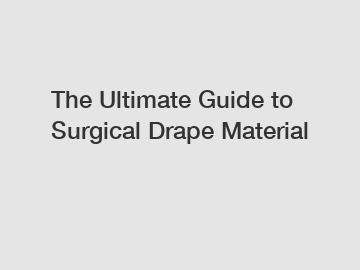The Ultimate Guide to Surgical Drape Material
The Ultimate Guide to Surgical Drape Material: What Should You Know?
Surgical drapes play a crucial role in maintaining sterility during surgical procedures. These protective coverings are essential in preventing contamination, reducing the risk of infections, and promoting successful outcomes. Choosing the appropriate surgical drape material is paramount in ensuring patient safety and well-being. In this comprehensive guide, we will delve into the different types of surgical drape materials, their characteristics, and factors to consider when selecting the ideal material for your surgical needs.
1. The significance of surgical drape material:

Surgical drapes act as a physical barrier between the surgical site and other potential sources of contamination, including the operating room environment and healthcare personnel. The material used in surgical drapes should possess key attributes such as impermeability to fluids, high tensile strength, tear resistance, and low linting properties. These factors ensure effective protection against both microbial and non-microbial contaminants.
2. Non-Woven Polypropylene:
Non-woven polypropylene is one of the most commonly used materials for surgical drapes. It is a synthetic fabric made from polypropylene fibers that are bonded together. This material is cost-effective, lightweight, and has excellent fluid repellent properties. Non-woven polypropylene drapes offer high microbial barrier protection and are resistant to tears and punctures, making them ideal for various surgeries.
3. Polyethylene Film:
Polyethylene film drapes consist of a thin, flexible plastic sheet that provides excellent barrier properties against fluids. These drapes are impermeable to both liquid and bacterial penetration, ensuring a reliable shield for the patient. Polyethylene film drapes are commonly used in procedures where large volumes of fluids are expected, such as orthopedic surgeries, urological procedures, and cesarean sections.
4. Absorbent Fabrics:
Absorbent fabrics, such as cotton or rayon, are often used as reinforcement materials in surgical drapes. These fabrics are highly absorbent, helping to manage fluids that may pool during the surgery effectively. The incorporation of absorbent fabrics in specific areas of the drape helps maintain a dry operative field and prevents fluid from spreading to non-sterile areas.
5. Specialty Drapes:
Certain surgeries require specialized drapes to address unique challenges. For example, microperforated drapes are utilized in procedures that involve laser surgery or electrocautery. These drapes offer optimal airflow while minimizing the risk of surgical fires. Similarly, impervious plastic incise drapes are used to create a sterile surface over the surgical site, ensuring a controlled surgical field and reducing the risk of contamination.
6. Factors to consider when selecting surgical drape material:
When choosing the appropriate surgical drape material, several factors should be considered, such as the type of surgery, anticipated fluid exposure, duration of the procedure, patient allergies, and clinician preference. Each surgical specialty may have unique requirements that necessitate the use of specific materials or drape configurations.
7. Environmental Impact:
In recent years, there has been an increasing focus on reducing the environmental impact of healthcare practices. Sustainable alternatives to traditional surgical drape materials are emerging, including biodegradable materials made from renewable resources. While these options may still be in the early stages of development, they present an exciting avenue for enhancing both patient care and environmental sustainability.
To conclude, selecting the right surgical drape material is a critical decision that directly impacts patient safety and surgical outcomes. Understanding the various materials available, their characteristics, and the specific requirements of each procedure is essential for clinicians and healthcare providers. By considering factors such as fluid resistance, tear resistance, absorbency, and specialty needs, healthcare professionals can make well-informed choices that enhance patient care and maintain optimal sterility in the operating room. So, next time you find yourself selecting surgical drapes, ask yourself: What is the ultimate guide to surgical drape material?
If you want to learn more, please visit our website operating room Disposable surgical drapes, disposable reinforced surgical gown, disposable laparotomy pack supplier.
234
0
0


Comments
All Comments (0)